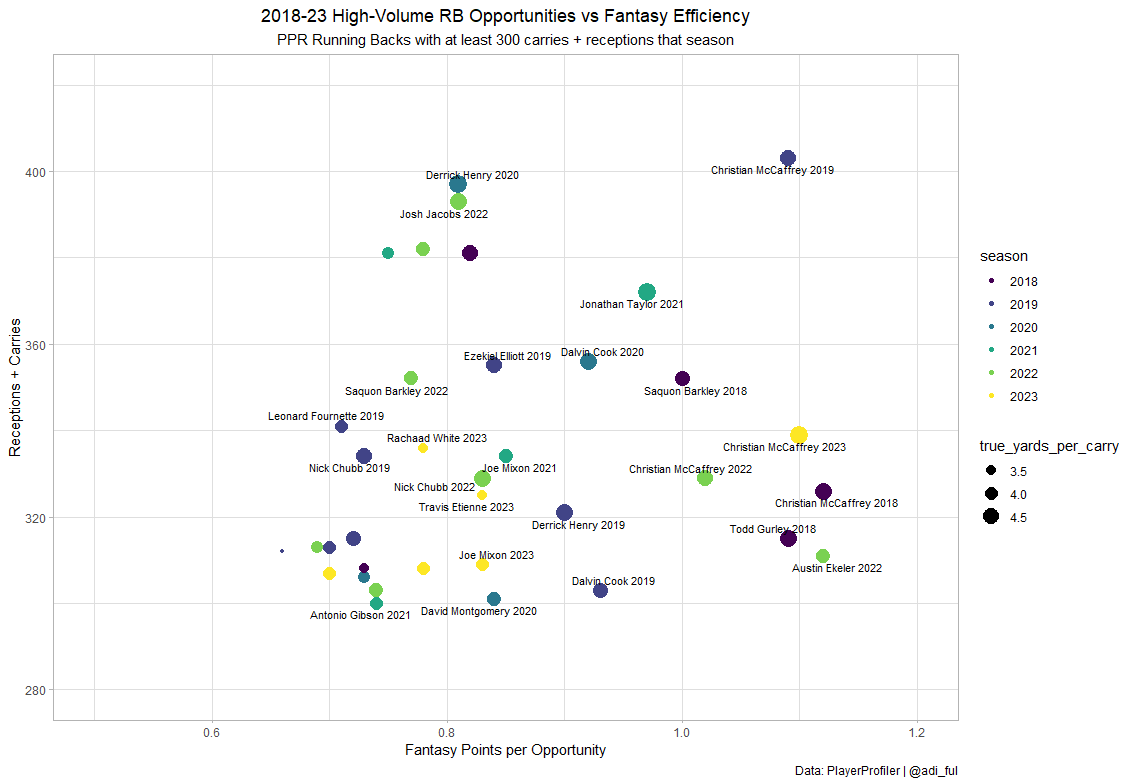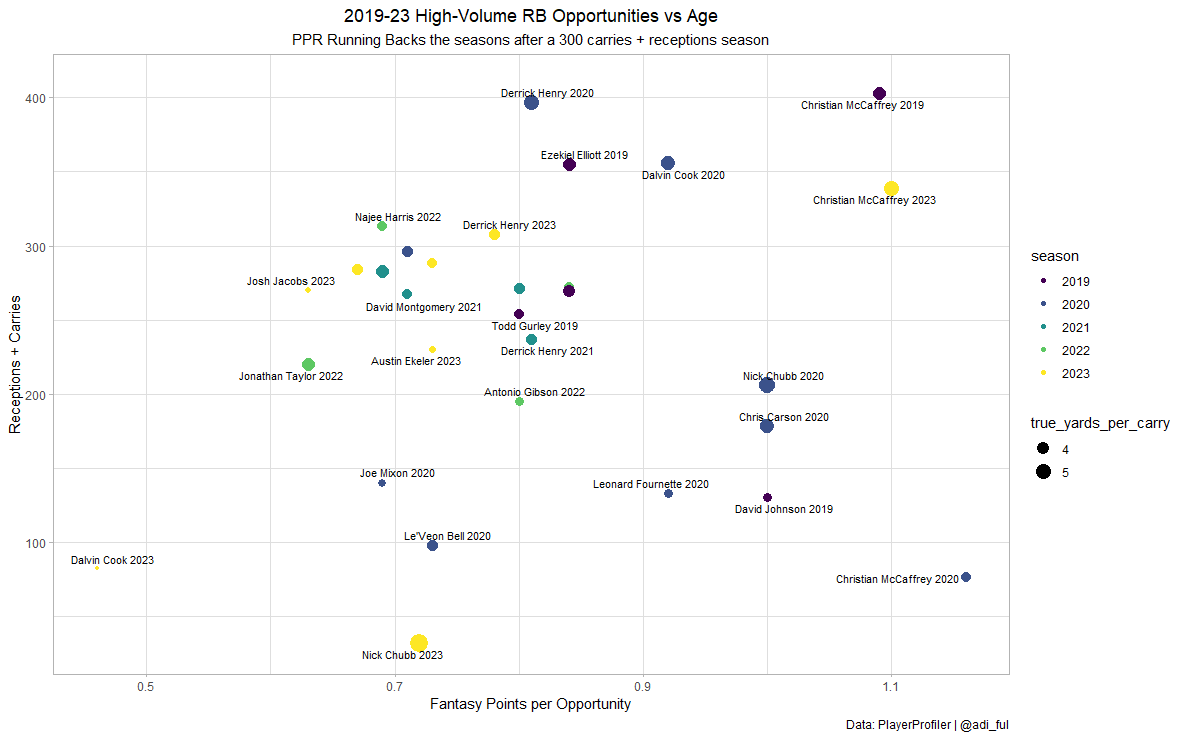While running backs can be a commodity in fantasy football, they are decreasingly valued in the NFL. This causes them to have the most distinct age apex of the position groups. It also means that increased volume runs out a running back’s tires, so to speak. In this piece, I explore the last six seasons of RB data to see the impact of high-volume touches (six because 2023 backs don’t have a “next season” yet). A curse or a death sentence to RB production, high volume is not easy to maintain for running backs.
PlayerProfiler is home to award winning dynasty rankings and tools. Our Dynasty Deluxe package includes complete Dynasty Rankings, Rookie Rankings, Trade Analyzer, Draft Planner, Mock Drafts, and more. Check it out.
The 300 Opportunity Club
It is becoming increasingly rare for running backs to see 300 opportunities in a season, let alone 300 carries. Over the last six seasons, a 300-carry workload has happened 10 times. Ezekiel Elliott and Derrick Henry are the only two to receive this workload more than once. Henry is the only one to see over 350 carries. Seasons with 300 touches (carries + receptions) are a little more common as the high volume indicates workhorse backs.

FPPO, touches, and True Yards per Carry for seasons in which an RB gets 300+ touches
Naturally, lesser True Yards per Carry means fewer Fantasy Points per Opportunity. Christian McCaffrey dominates the right side of the plot, marking himself as the true elite outlier to running back volume and production. The majority of the other running backs produce well for the high volume, with the high opportunity making them valuable for fantasy.
Guys with good athletic profiles and/or high passing game usage appear in this category. Chris Carson, Tony Pollard, and Austin Ekeler are the only players that weren’t day one or two draft picks on this list. So, team investment has a high impact – either high draft capital or big contract/trade. However, a big contract indicates an RB is past their rookie deal and is getting more volume, reaching the end of the age apex.
Is the High Volume a Curse?
After a running back gets a high-volume season, what happens? Let’s take a look at the seasons after a back received 300 touches.

FPPO, touches, and True Yards per Carry for seasons after an RB gets 300+ touches
Out of the 36 seasons of 300+ touches, there were seven repeats with 300+ touches the year after. Four of these repeats belonged to outlier workhorses McCaffrey and Henry. Injuries and decreases in efficiency can take hold the season after receiving high volume. The following table shows the percentage of running backs receiving certain efficiency thresholds (percentages used as 2023 backs do not yet have a “next season” of data).
Less running backs hit efficiency thresholds the season after a 300+ touch season. There is a less likelihood of backs getting that workload again, with factors like injuries, increased competition, or general inefficiency playing a role.
For example, CMC in 2020 and Nick Chubb in 2023 saw major injuries the year after a 300+ touch season. Other guys see dips in efficiency and usage, like Dalvin Cook‘s 2023 season with the Jets after the Vikings gave him 303 touches in 2022. Players can be let go by teams looking to go younger and save money, like Joe Mixon in the 2024 offseason. Ultimately, the top workhorses see 2-3 seasons of 300+ touches, while the elite outliers can get more. Pass-catching backs like Antonio Gibson can sneak into the 300-touch club, but will not spend much time there, usually seeing decreases in production after that.
The Rare 370 Touch-Club
The guys seeing at least 370 carries and receptions tend to be the top-tier fantasy producers. Christian McCaffrey, Derrick Henry, Josh Jacobs, Najee Harris, Ezekiel Elliott, and Jonathan Taylor from the last six seasons fall into this category.

RBs with 370+ touches over the last six seasons
In his next season, McCaffrey in 2020 played three games. He, Elliott in 2019, and Henry in 2021 and 2023 got over 0.75 Fantasy Points per Opportunity. The others saw less. CMC would recover the next few seasons of his career to be RB1.
Out of the seven 370-touch seasons from these six running backs, only Elliott in 2019 and Taylor in 2022 saw over 4.0 True Yards per Carry. They were still under 25, and Taylor missed a few games his season. Elliott had the best recovery after a 370-touch season, but would decrease in efficiency years after, now barely maintaining Dynasty relevancy at 28-years-old.
A high-volume RB like this is rare, with Henry the only one with multiple 370+ touch seasons. He and CMC are the rare outliers, with Elliott also touching that category briefly early in his career. Most RBs see a decrease in fantasy production after receiving this high a volume. The 370-touch season is almost always a peak and is therefore a curse indicator for running backs in Dynasty, more often than not.
What Does This Mean for the Future?
In 2023, six running backs saw over 300 touches. McCaffrey, Henry, Joe Mixon, Rachaad White, Tony Pollard, and Travis Etienne. McCaffrey is the No. 1 option in redraft leagues universally, likely to get another similar workload barring injury. White and Etienne, still under 27, are younger backs poised to still have high opportunity, but are unlikely to be long-term workhorses.
Henry, Mixon, and Pollard still have the chance to be relevant but are at the end of their age apexes and saw decreased efficiency. In fact, CMC was the only 2023 high-volume back to average over 4.0 True Yards per Carry. This does not bode well for the long-term efficiency of the others, with high volume leading to decreased efficiency and thus lower volume in the future.
Jahmyr Gibbs. Fantasy Rookie of the Year candidate. pic.twitter.com/oiURG7bn1t
— NFL Fantasy Football (@NFLFantasy) December 17, 2023
Bijan Robinson and Jahmyr Gibbs are poised for high workloads moving forward as recent first-round picks. The CMC and Henry tier looks to be unattainable for longevity of high volume and production, but Robinson and Gibbs are the next candidates for at least multiple seasons of high volume without a huge production fall-off. Kyren Williams is another candidate who saw high volume but was hurt in 2023 and did not reach 300 touches.
Takeaways
300 touches is a high crest for running backs to reach, marking a workhorse running back in the modern era of committees. It is increasingly more difficult for backs to repeat the high volume with the same efficiency, let alone repeat with the same volume due to injuries, new backfield competition, and more. If you had a running back not named McCaffrey or Henry, you got 1-2 good seasons of 300 touches before a noticeable production decrease. When looking at your Dynasty RB room, the peak “sell high” period for a high-volume running back is often after a season or two of 300 touches. If a running back hits 370 touches, that is an even stronger indicator of needing to deal him.
For more from Aditya Fuldeore, check out his Tight End Strategy in Dynasty article – Fantasy Tight Ends Scoring and Dynasty Strategy – PlayerProfiler


